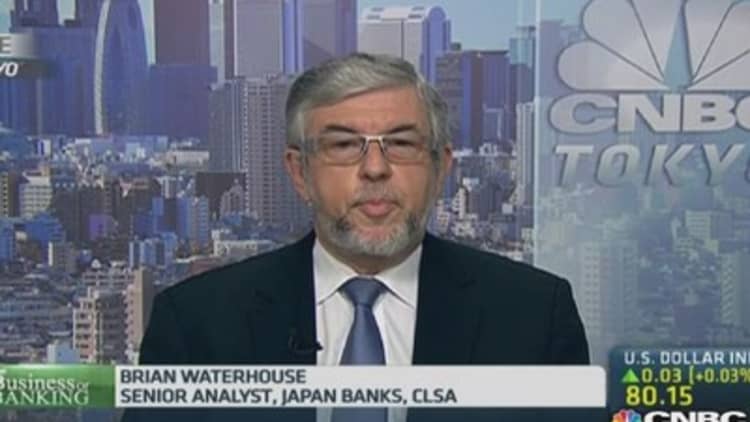Myanmar faces a familiar rite-of-passage for frontier markets: a major Western fast-food chain is poised to enter its market, even though widespread poverty puts its restaurants out of reach of much of the population.
"The entry of a well-recognized QSR (quick-service restaurant) brand is a signal from Myanmar to the world that the frontier market is open for business," Vikram Chakravarty, transaction advisory services partner at EY, said via email.
Read More McDonald's goes East: McNuggets come to 'Nam
Yum! Brands' KFC chain, in partnership with conglomerate Yoma Strategic, plans to enter the one-time pariah nation sometime in 2015, the companies announced this week, taking a bet that a country where gross domestic product (GDP) per capita was only around $1,700 last year will embrace its fried chicken.
While fast-food chains are often accused of being too expensive or of overshadowing local food and customs, "Western QSR often brings significant benefits to the farmers, food supply chain and food safety standards," Chakravarty said. "QSRs also usually put a significant drive to localize and price their products affordably."
Others also see a "French-fry" indicator on the rising fortunes of consumers in a country that until 2011 was largely isolated amid international opposition to its military dictatorship.
Read More Myanmar hotels set for record growth in 2014
"This is an economic signal" that disposable incomes will become sufficient to support the relatively low price barrier for KFC's products, Tony Nash, global vice president at Delta Economics, said via email. "It's also a sign that Western companies see the business environment in the country as a positive one."
It is a big bet on the future.
Only around 4 percent of the people in Myanmar are members of the "consuming class" -- or those with incomes of more than $10 a day on a purchasing power parity basis -- well below the global level of around 35 percent, according to a McKinsey Global Institute report last year.
Even those able to afford a bucket of the Colonel's secret recipe may have other plans for their funds. Myanmar consumers are often more interested in buying entertainment products, especially VCRs, Boston Consulting Group said in a report late last year.
Read More The final investing frontier: Nigerian beer?
"When Myanmar consumers do shop, they tend to buy basic goods and services. Fewer than half of urban residents buy chocolate, ice cream, or fresh milk. Only about one-quarter go on vacation and fewer than four out of ten frequent restaurants," BCG said.

But both McKinsey and BCG point to the potential for growth in Myanmar's consumer class. BCG expects the "middle-class and affluent" consumer (MAC) population will nearly double to 10.3 million in 2020 from 5.3 million in 2012, although that compares with around 6 million MACs in Bangkok alone.
Read More Frontier markets' bumper rally: Too far, too fast?
In a sign of how different frontier-market consumers are from their emerging-market counterparts, BCG noted "an affluent consumer in Myanmar today has the same purchasing power as a new member of the middle-class in Thailand."
Whether Myanmar's consumer population is fully ready for fast-food or not, some expect Western-style fried chicken will get a warm embrace from those who can afford it.
"Just like KFC is still one of the leading and fastest growing fast food franchising chains in Vietnam since its first outlet in Ho Chi Min City in 1997, we expect an equally positive reception to KFC in Myanmar," Tan Ai Teng, an analyst at DBS, said in a note this week. "We are positive that Myanmar's close to 6 million urban population would contribute profitably to KFC outlets rather quickly."
Read More Indonesia - E-commerce's new frontier market?
KFC may initially take a piecemeal approach to selling its food to the country's consumers.
"Consumers in Myanmar may not yet be looking to (or able to) incorporate KFC into their daily routine, but they are likely eager to try out a branded experience," Elizabeth Friend, a senior analyst of consumer foodservice at Euromonitor, said via email. KFC will need "multi-tiered" pricing, with full meals for high-income consumers and lower-priced snacks, desserts and beverages for those who want to experiment, but can't afford a meal, she said.
Friend also expects the secret recipe will catch on quickly.
"KFC is a smart choice as an initial launch," she said.. "Chicken is popular in Myanmar, and it is by far the operator's most popular and well-known global brand in Asia."
And if locals can't stretch their budgets for fast-food just yet, it's possible tourists might pick up the slack.
Myanmar saw more than 2 million tourist arrivals last year, nearly doubling from the previous year, with expectations the numbers will continue to rise.
—By CNBC.Com's Leslie Shaffer; Follow her on Twitter @LeslieShaffer1


